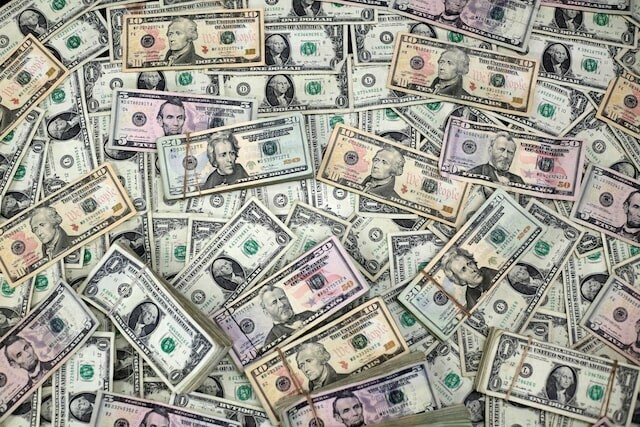After shedding nearly 3,900 points during the previous session, the Pakistan Stock Exchange (PSX) rebounded with the benchmark KSE-100 gaining over 1,400 points during the opening hours of the trading on Tuesday.
At 9:40am, the benchmark index was hovering at 116,355.79, an increase of 1,446.31 points or 1.26%.
Buying momentum was observed in key sectors including automobile assemblers, cement, chemical, commercial banks, oil and gas exploration companies, OMCs and refinery. Index-heavy stocks including HUBCO, ARL, PSO, SNGPL, MARI, OGDC, PPL, HBL, MCB and NBP traded in the green.
On Monday, after plunging nearly 8,700 points, the largest ever intraday decline in terms of points, the benchmark KSE-100 Index recovered over 50% of its losses and settled at 114,909.48, still lower by 3,882.18 points or 3.27%.
Globally, Asian stocks bounced off 1-1/2-year lows, and U.S. stock futures pointed higher on Tuesday. Markets caught their breath after recent heavy selling on hopes that Washington might be willing to negotiate some of its aggressive tariffs.
US Treasury yields continued their ascent from six-month lows, gold hovered close to a 2-1/2-week low and crude oil recovered from a nearly four-year low, as traders began shifting back to riskier assets from traditional safe havens.
A 5.6% rebound in Japan’s Nikkei far outpaced other regional markets, with Treasury Secretary Scott Bessent and Trade Representative Jamieson Greer tasked with leading trade negotiations with Tokyo.
US business leaders have also begun speaking out about the damage to the economy and financial markets that could be wrought by President Donald Trump’s global trade war, with JPMorgan Chase CEO Jamie Dimon warning on Monday of inflation and a US slowdown.
However, Trump dug in his heels over China, vowing additional 50% levies if Beijing does not withdraw retaliatory tariffs on the United States. Beijing said on Tuesday that it would never accept the “blackmail nature” of US tariff threats.
Even so, Hong Kong’s Hang Seng climbed 1.7% in early trading. Mainland Chinese blue chips added 0.6%.
The Chinese yuan weakened to 7.36 per dollar in the offshore market, the weakest in two months.
This is an intra-day update
Tariffs: MoC team to visit Washington
PSX rebounds, KSE-100 gains 1,400 points in early trade
Intra-day update: rupee remains stable against US dollar
Pakistani fintech Haball secures $52mn funding to grow Islamic finance business, plans Middle East foray
Aurangzeb meets ECO Secretary General to boost regional cooperation
Rs23bn TSG allowed for immunisation drive
Oil prices climb 1% after heavy US tariff-driven selloff
PM outlines plan to reform maritime sector
Mari Energies announces 4th discovery of hydrcarbons at Spinwam-1 well
Expanding OMC network in Balochistan: stepped-up action ordered
Electricity tariff cut: APTMA seeks clarification
Intra-day update: rupee remains stable against US dollar
The Pakistani rupee remained largely stable against the US dollar, appreciating 0.01% during the opening hours of trading on Tuesday.
At 10am, the currency was hovering at 280.55, a gain of Re0.02 against the US dollar.
On Monday, the currency settled at 280.57.
Internationally, the safe havens yen and Swiss franc held near six-month highs on Tuesday while the US dollar nursed broad losses as financial markets grappled with mounting recession worries in the wake of President Donald Trump’s sweeping tariffs.
The currency markets were fragile but eerily calm in Asian trade after a volatile 24-hour period where the dollar reversed heavy losses against the safe haven currencies as traders took stock of the risk of a rapidly escalating trade war.
In currencies, investors have flocked to the Japanese yen and Swiss franc in the past week, seeking shelter from the market turmoil in traditional safe havens.
The yen was last slightly stronger at 147.325 per US dollar, near the six-month high of 144.82 touched on Friday. The Swiss franc last fetched 0.85665 per US dollar, also near a six-month high touched in the previous session.
While the dollar is typically known as a safe-haven asset, that status seems to be eroding as uncertainty over tariffs and concern over their impact on U.S. growth intensify.
Investors are wagering that the rising risk of an economic downturn could lead to a cut in U.S. interest rates as early as May and with more easing priced in this year, that would erode the dollar’s yield advantage.
The dollar index, which measures the US currencies against six other units, was 0.44% lower on Tuesday. The index is down over 1% since the tariffs were announced last week.
Oil prices, a key indicator of currency parity, rose more than 1% on Tuesday, rebounding after a hefty selloff in recent sessions led by concerns that U.S. tariffs might depress demand and lead to a global recession.
Brent futures were up 81 cents, or 1.26%, at $65.02 per barrel, while US West Texas Intermediate crude futures rose 92 cents, or 1.52%, to $61.61, at 0051 GMT.
On Monday, oil prices slid 2%, nearing a four-year low, due to fears that U.S. President Donald Trump’s latest trade tariffs could thrust global economies into recession and diminish energy demand. Markets, however, anticipate a potential limit to the downward trajectory of oil prices.


Post a Comment